Atopiana

| |
| Flag of Atopiana | |
| Motto: All Are Free (1991-2105); Action! Unity! (2105-current) | |
| No Map Available Yet | |
| Region | Iron Curtain |
|---|---|
| Capital | Grantham (1991-2100), Kurskograd (2100-current) |
| Official Language(s) | Russian, Brznovian |
| Leader | Supreme Peoples' Council - Comrade-Chairperson-Elect (1991-2105); First Atopian - Anja Frank (2105-2162) |
| Population | 1,029,000,000 (1.029 billion) - est. 2105 |
| Currency | Workscrip |
| NS Sunset XML | |
Contents
- 1 The Creation of Atopiana
- 2 Atopiana - An Experiment in Anarchism
- 3 The Atopian Workers' and Peasants' Militia
- 4 The Grand Line and the Atopian Air & Nuclear Defence Complex
- 5 The Fascist Revolution
- 6 The Atopian Strategic Rocket Forces
- 7 Atopiana's Military Victories
- 8 The End of the Dream
- 9 Atopian Military Industry
- 10 The Atopian Fighting Woman of 2110
- 11 The Atopian Fireteam of 2110
- 12 Disaster and the Exodus
The Creation of Atopiana
Brzno in Flames
Following the collapse of the Soviet Union in 1989-90, the Socialist Republic of Brzno fell into a prolonged and bloody civil war. Located in the south-western corner of the USSR, it had been occupied by the Germans during WWII, and, earlier, been heavily influenced by the Ukranian anarchist movement. Together with the Soviet legacy and its own historical religious tensions between Catholics, Jews, Muslims and Orthodox christians, the stage was set in 1989 for a break up to rival that of the former Yugoslavia.
The Communist Party of Brzno (CPB) tried in vain to retain its iron grip on the nation, but when the banned National Socialist Brzno People's Party (NSBWP) rose - and with it a significant chunk of the armed forces, particularly the Catholics from the province of Skgorria - other armed factions rose in opposition. Within a month, Brzno had fractured into its provinces. Skgorria and the NSP were prevented from taking the central Grossetape province by a combined effort by the Brzno Anarchist Federation and the Atopian Worker's Party, a nationalistic left-wing group located in the southern Atopia region. The leftist alliance was rapidly dominated by the highly organised Anarchist Federation, which instituted a program of Makhnovist reform in order to ensure a successful revolution.

Above: A Brzno army artillery unit fighting for the Atopian Anarchist Federation fires Harrassment and Interdiction into Skgorrian lines, June 1991
Meanwhile, Grossetape became a battleground. It was fought over by the divided Brzno armed forces and the militias that became rapidly common on all sides. The Grossetapens themselves demanded independence, and fought to achieve this. To the north-west, three smaller provinces united as the 'Federation of Katarznya', and established a centre-right government. The CPB had, by the start of 1990, almost ceased to exist as a viable force, and settled into a pattern of guerilla raids across what had been Brzno.
By late 1993, the fronts had stabilised, and fighting began to die down. However, it wasn't until March 1994 that peace at last came to the region, and the new nations could begin the task of establishing themselves properly.
Atopiana - An Experiment in Anarchism
Atopian Society
Atopians organised themselves along lines of mutual solidarity for over a hundred years following the break-up of Brzno. Throughout the anarchist period, society was organised in mutually-co-operative groups known variously as 'collectives', 'councils' or 'federations'. These encompassed blocks of flats, sports teams, fishermen, and even factories. Money was replaced by workscrip, which was used alongside barter and the use of huge warehouse-depots full of clothes, food, and other essentials.
Complete freedom of speech, thought, and expression was prized above all, leading to a thriving culture. Prisons were closed and police replaced by the concept of social solidarity; which lead directly to a rapid fall in crime - principally because the only crime was 'serious anti-social behaviour' such as murder and rape, both of which were, by 2034, almost non-existant. Indeed, by 2078, one academic survey concluded that those offences carried out in the previous decade had all been the work of genuinely disturbed individuals who would have offended regardless of the society in which they lived.
Inevitably, however, such a social system inspired counter-revolutionary groupings, the most famous of which was the Atopian Union of Fascists (AUF). They met openly, and were for the most part ignored or ridiculed by the majority of Atopians. Indeed, despite the civil war in 2104-05, many consider the existence of such counter-revolutionary societies to have been beneficial to the progress of Atopiana from 1991-2104.
Atopian Politics
From 1991 to 2104, politics was simple - you were an Anarchist. Even those who purported to be otherwise were inevitably coming at various questions from an anarchistic point of view. It was only with the AUF's creation in 2080 that a really serious alternative ideology was espoused by more than twenty or so people at any one time.
The gradual spread of the AUF from 2080 onwards culminated in the Rising of 2104, which in turn led to the Fascist takeover in 2105. Even after this period, however, it took many decades to turn Atopiana into a truly Fascist society which, in Mussolini's words, was "All within the State, nothing outside the State".
By the death of Primo Frank and the installation of Primo Lassaert, however, there was only one option - you were in the Party or you weren't a citizen.
The Atopian Workers' and Peasants' Militia
Established in 1992, the AAF's military wing was at first simply a name for the conglomeration of forces that had been fighting to establish Atopian independence, but by 1994 the AWPM had been organised into a formidable and flexible fighting force. Based around the principle of combined arms operations, it had organised itself into groups known as Columns, each of around 1,000 men and women. At the end of the war, there were some 200 Columns, but this number has since been increased in order to cope with the Skgorrian military build up and the exponential increase in population.
Each Column generally comprises four Infantry Centuries of about 100 infantry with light arms (mortars, heavy machine guns, automatic grenade launchers and RPG-7s for example), two armoured Centuries of some 40 tanks and light armoured vehicles (most often T-64s with BRDMs in support, although some use T-54/55 and others still only have access to technicals or PT-76s), two artillery Centuries with a mix of towed and self-propelled field guns, and two anti-aircraft defence Centuries with a mix of towed and self-propelled AAA. Most Columns use shoulder-fired AA missiles where possible, and some have SAM-2 and SAM-6 units, although the majority utilise the ZSU-23-4.
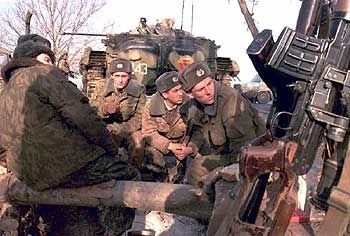
Above: AWPM unit - still wearing Soviet insignia - on exercise, winter 1996.
In 2000, there were some 600 Columns, with one (Black Guard) deployed to West Corinthia, and four (Mahkno, Ravachol, Free Earth Army and the secretive Special Column) being readied for deployment to the wartorn region of Khurzav for Peacekeeping Operations. These last four were never eventually deployed, while the Black Guard eventually left West Corinthia following a short engagement with Corinthian and Skgorrian forces. The Black Guard evacuated over 700 West Corinthians, who formed the West Corinthian People's Liberation Army.
The remaining Columns were kept within Atopiana as a defence force against any possible incursion by Skgorria, Grossetape or Katarznya. The Grand Line, begun in 1992, continued to be reinforced annually.
The late 20th and early 21st Century Atopian People's Militia used the following infantry weapons:
AKM-74 assault rifles with GP-30 underbarrel grenade launchers; AK-47 assault rifles; PMM Makarov pistols; SV-98 sniper rifles; Dragunov SVD sniper rifles; Pecheneg GPMGs; RPK-74 LMGs; Saiga-12 shotguns; A-5 submachine guns; KPV heavy machine guns; Kornet E shoulder-fired anti-tank rockets; and RPG-7V shoulder-launched anti-tank rockets.
The ground vehicles used by the APWM included:
T-64, T-80 and T-95 MBTs; BMP-3 AIFVs; UAZ-469 light wheeled vehicles; 9k58 Smerch AA systems; ZSU-23-4 and Tunguska-M AA vehicles; and BTR-90 wheeled armoured reconnaisance vehicles/APCs.
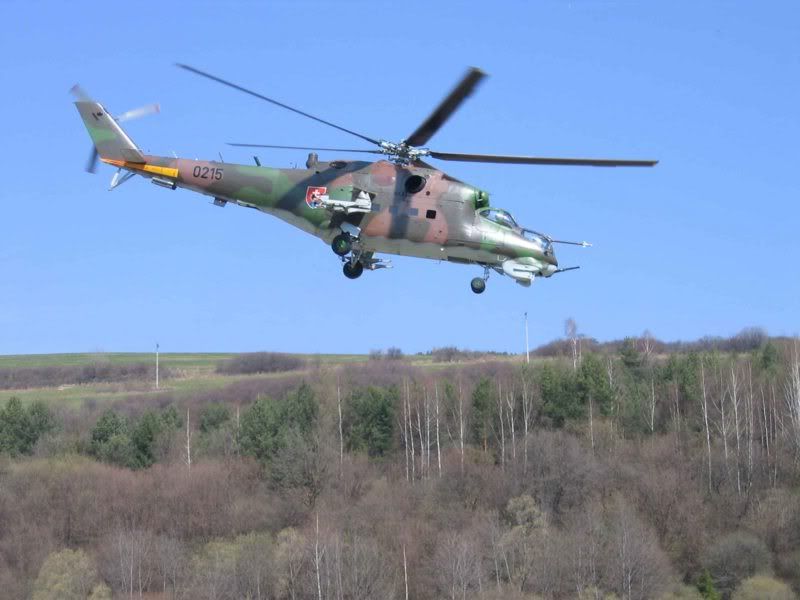
Above: An Atopian Hind-D comes in low across the forests of West Corinthia in support of the Black Guard.
In the air, the AWPM equipped itself with late-generation Soviet equipment, purchasing more and more in an attempt to adequately defend the airspace of Atopiana. Hind-Ds, Ka-50 Kamov attack helicopters, Su-25 Frogfoot, and other vehicles including Tupelov Tu-160s were all in operation by 1999. Over the next few decades, many more of these were purchased in order to ensure a large, professional, air force.
Transport and logistical aircraft were also procured in large amounts, particularly Antonovs. Smaller transports were used by elite Columns such as the Ravachol Column and the Special Column for insertion by parachute - and, indeed, three Columns were entirely airmobile by 1997, increasing to five by 2002.

Above: A Special Column trooper performs a HALO jump into 'hostile' territory during Exercise Blue Circle, 1998.
Together with pre-existing weapons and equipment, the AWPM in the early 21st Century were very heavily equipped and well able to aggressively defend the revolution.
The Local Defence Councils
If the AWPM were Atopiana's professional military - and they were - then the LDCs were Atopiana's paramilitary militia. Comprised of volunteers from each village, town, city, factory and even football clubs, their task was to defend their immediate locality. Lightly armed and equipped, they nonetheless posed a serious obstacle to any potential invader. Roughly equivalent to the Home Guard or Volkssturm of the Second World War, the LDCs never saw active service until 2105, during the Atopian Civil War.
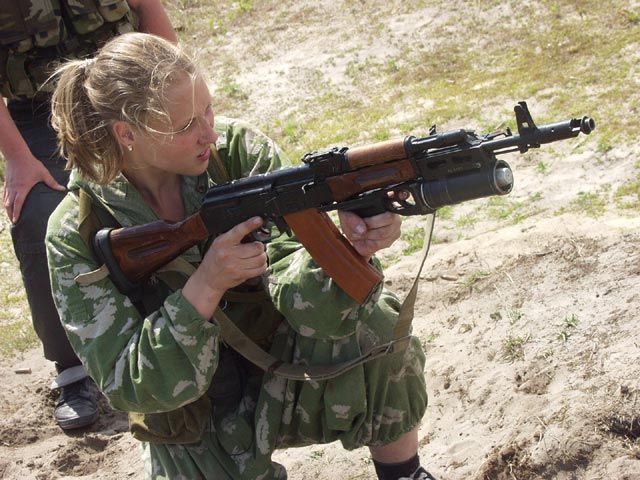
Above: A volunteer in the Grantham LDC during firearms training. Note lack of body armour.
The LDC, despite its light equipment, performed a vital role. In freeing up the Columns of the AWPM, they enabled their professional comrades to not only effectively and rapidly respond to any external or internal threat. Further, their existence enabled the AWPM to be deployed abroad several times, particularly in the case of West Corinthia.
Atopiana's Space Force
Launching from the Alto Spaceport, the ASF made its first flight in 2003. Using Soviet-era technology (which would later be improved on by Atopian manufacturing), the first satellite - a geo-stationary telecommunications module. Within the year, there were ten satellites in orbit, and the beginnings of the INTELSAT network were in place. By 2010, INTELSAT comprised 50 satellites - and by 2017, with the launch of the first ASF space shuttle, INTELSAT began giving Atopiana real-time information about any point on the earth.
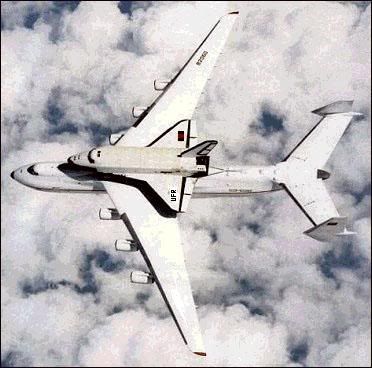
Above: March 5th, 2017, and the first ASF shuttle is test-flown. Below: Blueprints for the Aero-Buran shuttle.
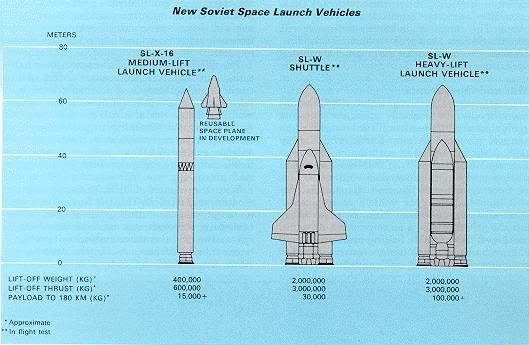
In 2045, with the space shuttle fleet standing at ten examples, and there being at least five launches a year, the ASF was in a position to begin work on Freedom One (later renamed Fasces One). Freedom One, launched the year that Atopiana's population hit the one billion mark, became one of the largest space stations in orbit within 18 months of building work. By 2048 it had a crew of twelve and was the control hub for INTELSAT. By 2050, it could support twenty people indefinitely, and had its own artificial gravity thanks to centrifugal force.
The Grand Line and the Atopian Air & Nuclear Defence Complex
This border defence, some six miles deep, runs along the length of the border, particularly with Skgorria and Grossetape. Its constructon began during the last weeks of the War of Indpendance in 1991, and has been continued yearly ever since. From its humble beginnings as a trench system, it now forms a continuous ring around Atopiana. It bristles with automated gun turrets, underground artillery pieces, and barracks.
Many commentators have compared it favourably to the Maginot Line, most memorably as "The Maginot Line on crack". During the Atopian Civil War, over 300,000 Skgorrian soldiers were killed and a further 500,000 wounded during the assault on the Grand Line, which eventually gave way to SS-Zionbane Division.
During the early part of the 21st Century, as Skgorria built up a commanding lead in the strategic arms race with massive air fleets and a nuclear weapons programme, the Atopian Supreme Council decided to channel funding into an extension of the Grand Line's underground bunker complex in order to provide shelter for the majority, if not all, of the population.
By 2076, the Atopian Air and Nuclear Defence Complex (AANDC) was complete. Able to house some 600 million people, it contains exercise chambers, nuclear power stations, water purifiers attached to specially constructed aquifers, hydroponic farms, battery farms for meat, fish and poultry, schools, barracks, housing blocks, and all the comforts of home life.
Further construction was carried out in the late 2090s, as the population grew, and now, in the early years of the 2100s, some 800 million people can remain underground indefinitely in the event of a nuclear assault. Regular drills under the auspices of the AUF mean that only ten minutes are required to fill the AANDC to capacity. Many consider the complex to be worth expanding once more, as the population continues to rise (passing the 1.1 billion mark in 2134).
The Fascist Revolution
The Atopian Union of Fascists
Our fascism is an ideology that celebrates the Atopian nation and the human race as an organic community transcending all other loyalties. The AUF heralds an era of national rebirth after the 114 year period of decline and destruction that existed under the anarchists. To this end, the AUF calls for a "spiritual revolution" against signs of moral decay such as individualism and materialism, and seeks to purge "alien" forces and groups that threaten the organic community.
The AUF celebrates youth, unity, and the regenerative power of action. We promote the doctrine of human superiority, imperialist expansion, and are not afraid to utilise extreme violence. We embrace internationalism based on racial and ideological solidarity across national boundaries. The AUF espouses equality of the sexes, and is led by Madam Frank, the Primo.
Our approach to politics is both populist--in that we seek to activate "the people" as a whole against our enemies--and elitist--in that we treat the people's will as embodied in the supreme leader, the Primo, from whom authority proceeds downward. The AUF organised a cadre-led mass movement in our drive to seize power. We have forcibly subordinated all spheres of society to our vision of organic community, through a totalitarian state. Both as a movement and a regime, we use mass organizations as a system of integration and control, and organized violence to suppress opposition.
We are hostile to Marxism, liberalism, and conservatism. We do not reject the principles of class struggle and workers' internationalism, instead seeing the working class as the upholders of the race's purity. The boss class is the insiduous evil which has backstabbed and oppressed the people for too long! We reject the liberal doctrines of individual autonomy and rights, political pluralism, and representative government as weak and foolish. Our vision of the New Fascist Order unashamedly clashes with the conservative attachment to tradition-based institutions and hierarchies. We look to the future to provide the basis for our doctrine of Action, that is, constant forward motion; and to the past for our doctrine of Unity, that is, solidarity against external enemies.
The Armed Forces
Following the victory of the AUF in the three-year long “War of National Resurrection”, the armed forces of Atopiana underwent significant changes. The Column system became the basis for a new, more classical, organisation. The AWPM was disbanded, and replaced with four organisations under the auspices of Military Command: Atopian Land Forces (ALF), Atopian Space Forces (ASF) Atopian Air Forces (AAF), and the Atopian Logistics Corps (ALC).
Conscription was introduced, and within a decade, fully 10% of the Atopian population – male and female – was a member of Atopian Military Command (which by now encompassed the Atopian Strategic Rocket and Space Forces). ALF was organised into ten Field Armies, each consisting of 500,000 men and women. The Field Army was further subdivided into five Corps of 100,000.
During the British Londinian War of 2118, Military Command controlled fully 133 million men and women, with a further ten million militia and youth organisation volunteers.
The basic building block of the Corps was the infantry platoon of four squads of eight troopers, each of which was equipped with top of the line armoured infantry fighting vehicles. Three 32 strong line platoons plus a HQ squad and a support platoon equipped with mortars, automatic grenade launchers and heavy machine guns comprised a company. In turn, three line companies and a HQ unit of 16 soldiers made up a battalion. Three line battalions, HQ platoon, and assorted supporting units such as tanks, artillery, anti-air assets, ambulances, engineering units, signallers, and so on formed a brigade of around 2,270 soldiers. Three brigades in turn formed a division – at this level including a HQ company, signallers, engineering units, artillery battalions, dedicated hospital units, military police detachments etc – of around 9,200 people.
Ten line divisions, then, comprised a Corps, with the difference made up of cooks, HQ security, general staff, and permanently attached special forces units. (For more details of equipment, see: Atopian Military Industry and The Atopian Fighting Woman of 2110.)
Regarded as the least exciting, but the most vital, part of the Atopian armed forces, is the Atopian Logistics Corps. This organisation controls all Atopian logistical units – mechanics, refueling bowsers, ‘super-carrier’ aircraft, and so on. Without the ALC, no military operations are possible. It is they who transport and keep supplied the hungry soldiers and equipment of the ALF and AAF. They are the lifeblood of Military Command, and draw many recruits from the fascist youth organisation, Future Strength, and the local volunteers of the Strength in Unity construction and work organisation.
The Shock Division
Comprised entirely of senior members and ex-members of Future Strength, the Shock Division's average age is 17. They are currently led by General Ganz, and are used whenever genocide or ethnic cleansing is on the cards, having trained extensively with the Special Action Division of Skgorria.

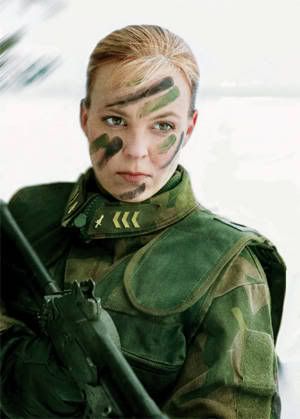
Above: Gen. Ganz and his aide-de-camp, Lt Willens. Below: Shock Division troopers relaxing in Skgorria after having exterminated a hundred sub-humans.
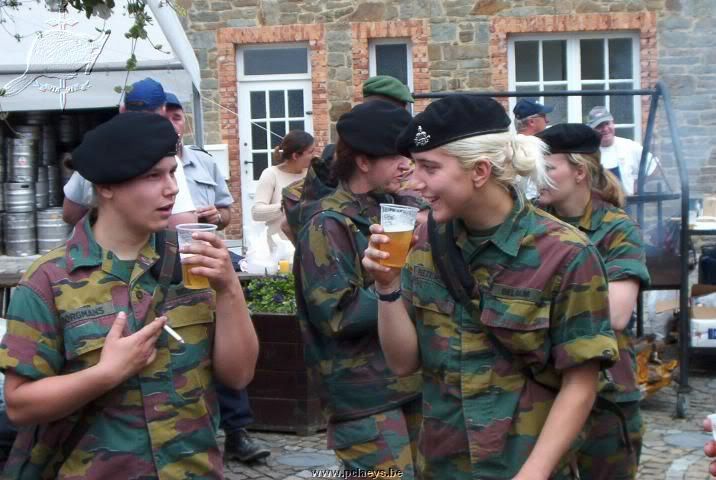
The Atopian Strategic Rocket Forces
Further details of this arm of the Atopian military can be found elsewhere. The content of this article revolves around the social, economic and political changes and constants within Atopiana, and as such the Atopian Strategic Rocket Forces are only discussed in relation to the political decisions that led to their creation in 2002, and their expansion between 2002-2150.
MORE TO FOLLOW
Atopiana's Military Victories
The British Londinium War
When a revolution occurred in British Londinium, designed to overthrow the Dual Monarchy of Emperor and Empress James and Hemali I, Atopiana stepped in alongside Skgorria to aid the Dual Monarchs. In the process of the revolution, the Dual Monarchs were deposed by the High Chancellor, whose politics were much more amenable to the Atopian Union of Fascists. As a result, the Atopian Expeditionary Force of one Army Group was expanded to three (a total of 221 infantry divisions) and the New Party of Robert Tranter given control of the 'Social Republic of British Londina', an area in the south of the country.
Following a counter-revolution to depose the High Chancellor, an Atopian invasion in support of the Chancellor and to secure the safety of Tranter's Social Republic became a full-blown invasion of Londinia following the announcement that the High Chancellor had been shot.
Within two days, the 221 divisions of Army Groups Centre, East and West had surrounded the capital city, Westminster, and driven ten miles further north. From this position an initial foray into the city was beaten back by fierce resistance and localised enemy air power. However, by the end of the week significant air assets - including 2,000 Tupelov/AtopiAir-100 Strategic Bombers and several hundred upgraded Su-47s - had arrived. Together with artillery units such as 1st Strategic Artillery (equipped with Godhammer nuclear artillery pieces), the Air Armada pummelled Westminster for days on end, reducing it to a shattered ruin. The three Londinian divisions defending it were reduced to just 10 thousand soldiers by the air raids.
Outside the city, Army Groups West, Centre and East had begun a general advance which, despite casualties from SSBMs launched by Londian naval assets (2nd Army was reduced to just two divisions as a result of these nuclear strikes), saw the 221 divisions advance over 150 miles in four days. A creeping barrage of gas and conventional shells escalated to Red Pill useage by 1st SA when the advance came under Godhammer fire.
By the end of the month, the Dual Monarchs had issued the following proclamation:
Instrument of Surrender
1. We the undersigned, acting by authority of the British Londinian High Command, hereby surrender unconditionally to the Fascist Union of Atopiana all forces on land, at sea, and in the air who are at this date under British Londinian control.
2. The British Londinian High Command will at once issue order to all British Londinian military, naval and air authorities and to all forces under British Londinian control to cease active operations forthwith, to remain in all positions occupied at that time and to disarm completely, handing over their weapons and equipment to the local allied commanders or officers designated by Representatives of the Atopian Supreme Commands. No ship, vessel, or aircraft is to be scuttled, or any damage done to their hull, machinery or equipment, and also to machines of all kinds, armament, apparatus, and all the technical means of prosecution of war in general.
3. The British Londinian High Command will at once issue to the appropriate commanders, and ensure the carrying out of any further orders issued by the Atopian armed forces.
4. In the event of the British Londinian High Command or any of the forces under their control failing to act in accordance with this Act of Surrender, the Atopian Armed Forces will take such punitive or other action as they deem appropriate.
Signed,
Empress Hemali I; Emperor James I; Field Marshal Sinclair, Supreme Commander of the British Londinian Expeditionary Force; The Right Honourable Chloe Lawashivi, MP, Minister for Defence
Following recipt of this surrender document, the GHQ, based in the Social Republic, issued what would become known as the Treaty of Westminster:
Instrument of Total Victory, the Treaty of Westminster
Being the Surrender Conditions imposed upon the defeated nation of British Londinia, this day of March the 8th in the Year 2118 Common Era:
1.1: The Dual Monarchs to cede all practical power to President Robert Tranter;
1.2: The Dual Monarchs to retain ceremonial duties;
1.3: The New Party, led by President Tranter, will form the Government of British Londinia.
2.1: The surrender of all Londinian overseas possessions as Atopian mandates;
2.2 The return of the Social Republic to Londinia after 25 years;
2.3: Westminster to become a Skgorrian city for the duration of the reconstruction;
2.4: Plebiscite to be held in Westminster on completion of the reconstruction to settle any quarrels over ownership, result to be honoured by Skgorria and Londinia;
2.5: Occupation and special status for the Social Republic under Skgorrian control.
3.1: The complete demilitarization and a fifteen-year occupation of Londinia by Atopian troops;
3.2: Londinian reparations of US$ 1 trillion, to be paid in annual installments of US$100 million;
3.3: A ban on the union of Nova Britannica and British Londinium.
4.1: Limitation of Londinia's army to 100,000 men with no conscription, no tanks, no heavy artillery, no poison-gas or nuclear weapons supplies, no aircraft of any sort and no drone equipment;
4.2: The limitation of the Londinian Navy to vessels under 5,000 tons, with no submarines, no nuclear weapons, drone equipment, and no aircraft of any sort.
5.1: All seized weapons and equipment will remain the property of Atopiana;
5.2: The Social Republic to turn control of its militias over to the New Party;
5.3: The New Party Militia to be advised by Atopian and Skgorrian officers;
5.4: British Londinium to sign a Non-Agression Pact with Atopiana and Skgorria.
The above terms must all be accepted for the current cessation of hostilities to become peace.
Signed, on behalf of the Primo of Atopiana:
Field-Marshal K. R. T. Anders, CinC GHQ British Londinium
Following a brief attempt by the Londinian government to negotiate more favourable terms, the war was declared over at 12:00 on the 12th of March 2118.
The End of the Dream
In 2105, 114 years after the establishment of the worlds' first Anarchist nation, Atopiana finally succumbed to years of Skgorrian and Grossetapian fascist fifth-columnist activity.
Internal Strife
TEXT
The Perils of Freedom of Speech
TEXT
Comrade Anja Frank and the Atopian Union of Fascists
TEXT
The AUF Coup d'Etat
TEXT
Skgorrian Intervention And The Civil War
TEXT
Atopiana Under the AUF
TEXT
Atopian Military Industry
1991-2020
For almost thirty years, Atopian military industry was confined to the purchase and production of late-generation Soviet and CIS equipment. By 2010, however, the majority of the AWPM was equipped with the best availiable weaponry – AKM-74s in vast numbers, for example – and Atopia’s military machine was second only to Skgorria’s. For this reason, most of Atopiana’s defence spending from 2010 onwards went on the Grand Line, and, intermittently, on upgrading Soviet-era technology.
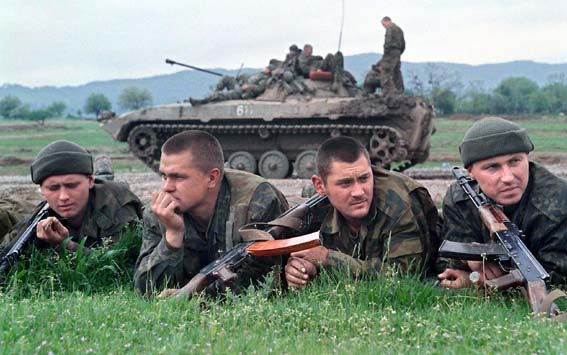
Above: Atopian Workers and People's Militia patrolling the Grand Line, 1998
Indeed, by 2014, all first-line T-95s were equipped with ERA armour blocks, side-skirts, anti-rocket mesh, and bolt-on composite armour plating where possible. The last T-54, a relic of the 1991 Brzno break-up, was decomissioned in 2015, and the last T-72 in 2017. By 2020, then, all tanks were T-80s or T-95s – and all of these had been extensively uprated and, in some cases, so refitted that they could hardly be called T-80s at all. Similarly, armoured personnel carriers such as the BTR were phased out in favour of the BMP-2 and -3 series armoured fighting vehicles, although trucks and lighter armoured vehicles remained in use by LDC and supply units.
From 2003 onwards, the majority of Atopiana’s small arms were manufactured in underground factories, and, by 2013 – only a decade later – most light armoured vehicles and many parts were indigenous builds. In the arena of computer technology, Atopian programmers and hardware manufacturers contributed greatly to the creation not only of the space programme, but to a nationwide military information system known as INTELSYS. This was later linked to INTELSAT, enabling any Atopian unit with INTELSYS capability to get real-time information from any other INTEL-enabled unit, drone, or satellite.
2021-2050
In the middle part of the 21st Century, even Atopiana’s upgraded Soviet technology was beginning to appear distinctly second-rate in the global arena. However, the immediate threat remained from Skgorrian and Grossetapen military units, who were also equipped with late-period Soviet technology. For this reason, the decision was taken to expend the defence budget on the Grand Line, integrated air-defence systems, and the space programme.
During the period 2021-50, vast sums were expended on procuring modern SAM and triple-A capability, as well as old-fashioned AAA systems for LDC useage. By the 2040s, Atopiana’s skies were well watched and patrolled. Few Skgorrian pilots could enter Atopian airspace and remain undetected for longer than three minutes.
The Grand Line, meanwhile, was extended to fully enclose Atopiana. It ran all the way around the country, extending some six miles from the border. Most of this distance was comprised of minefields, anti-tank ditches, and barbed-wire entaglements. The border itself was demarcated by an electric fence some 600,000 miles in length. Underground, the bunker complexes stretched for miles, containing factories, hydroponic farms, nuclear shelters, barracks, exercise rooms, cinemas, and so on. On the surface, most gun turrets had begun to be automated, although artillery pieces were still manned.
2051-2100
During the latter half of the century, as the anarchist majority struggled to contend with the rise of the AUF, military spending was reduced somewhat. However, by this time it was patently clear that not even the most modernised T-95 (now redesignated the T-2K series) could stand up in the global military environment. For almost fifty years, a long programme of replacement was put into place. Local Defence Councils would receive the Militia’s old equipment as the Militia was upgraded.
A series of solid-state electrically fired caseless small-arms was developed, based on the German G-11. This new weapons system – the Infantry Small Arms System (ISAS) – comprised a handgun (ISAS-9); rifle (ISAS-10); squad support weapon (ISAS-10S); and machine gun (ISAS-14). In all cases, the numbering of the weapon referred to its calibre – 9mm for the handgun, for example. Further additions were made, including a 40mm underslung grenade launcher for the rifle, enhanced optical systems, bayonets, and underslung 20mm high-explosive cannon.
To complement ISAS, the Infantry Weapon, Anti-Vehicle (IWAV) was produced. This shoulder-launched 300mm weapon fired an APFSDS round which could penentrate up to a metre of rolled homogenous steel armour plating, or 50cm of composite armour, at a distance of 200m.
In the field of armoured vehicles, further developments were made. The main battle tank was replaced with the All-Purpose Armoured Vehicle (APAV), which carried four soldiers in addition to its crew of two. The APAV was constructed from a lightweight armoured shell, which was in turn reinforced with composite plating. A remotely controlled turret contained a three-shot rocket launcher, a self-loading 130mm cannon, and a co-axial 25mm chaingun. The APAV was produced in both wheeled and tracked versions, and eventually equipped the reformed Atopian Armed Forces in the early half of the 22nd century.
Equally as overhauled were the Atopian air units. Unmanned drone aircraft began to take over from Hinds and Kamovs in the close-support role, while a high-flying long-range fighter-bomber – the Atopian Aerospace Federation 2100-E – complemented a new strike force of cruise missiles. Huge ‘super-carrier’ aircraft replaced the majority of logistical units, enabling the AWPM to airlift whole Columns with ease.
2100-current
Now equipped with the APAV, ISAS, IWAV and other ultra-modern killware, the AWPM had become a force to be reckoned with. However, the onset of the civil war in 2105 meant that the first combat use of their new equipment was, tragically, against their fellows. Where they saw action, however, they were nigh-unstoppable except by similarly well-equipped troops. T-2K armoured vehicles could, with luck, engage APAVs and win, but in most cases the APAV’s superior mobility, targeting, and firepower enabled swift victories for their crews. Equally, ISAS proved to be deadly – their caseless ammunition could penetrate body armour with ease, and, firing ceramic frangible rounds, caused horrific damage to unarmoured personnel.
Indeed, troopers using depleted-uranium rounds in their ISAS-10s and -14s found that they could knock out BMP-3s at close range, and in at least one case immobilised a T2KM. Drone aircraft found themselves engaging Hinds, Kamovs, and other updated late 20th Century vehicles with relativly mixed success. If they could aquire their targets first, the drones usually won – their air-to-air munitions were of a superior quality, and extremely hard to dodge or trick.
Following the AUF’s victory, the clearly outmatched vehicles of the LDCs were relegated to internal security tasks, and production of the latest killware was ramped up. The Grand Line, which had taken a horrendous toll on its Skgorrian attackers (upwards of 300,000 Skgorrians died before SS-Zionbane broke through as the defenders’ morale broke momentarily, and a further 250,000 or more were killed exploiting the gap that Zionbane had made. For the rest of the war Skgorrian units entered and exited Atopiana across the Zionbane Gap – and took casualties doing so), was revamped. Remote-controlled, self-loading, INTEL-linked weapons systems replaced crewed emplacements all along the Line. The underground bunker complex was extended into a nationwide ‘nuclear emergency shelter’, in order to provide living quarters for 800 million Atopians in event of a nuclear attack. In theory, the emergency shelter complex would keep these Atopians safe for as long as power held out – some two thousand years.
The Atopian Fighting Woman of 2110
Body Armour: Composite ‘carapace’ armoured suit with underlying breathable NBC-proofed skinsuit. Capable of stopping ISAS-14 rounds at 200m, and ISAS-9 at 100cm. Contains suit computer systems which monitor lifesigns and other biological activity, and which are programmed to inject a range of chemicals, anti-toxins, and other stimulants in event of injury or other mishap. Specialised dyes and paints enable the wearer to blend in with her thermal environment, rendering her practically invisible to enemy optical systems at distances of over 80m. Camouflage varies according to environment. The dyes and paints that make up the camouflage change colour according to the surrounding light, ensuring that unenhanced visual acquisition is as difficult as possible.
Helmet: Visor contains HUD displaying squad condition, localised INTEL information, ammunition avaliable, mission parameters, and other necessary information. Visor will always provide daylight levels of clarity regardless of environment, e.g. night-time or smoke. The helmet is fully enclosed and comes with rebreather and 48 hours’ oxygen provided by internal oxygen pack located on the rear of the armour. Each helmet contains an integral short-range high-power encrypted radio.
ISAS-9 handgun with six ammunition slabs, each of 25 rounds. Two slabs will contain frangible ceramic shot.
ISAS-10 assault rifle, bullpup. Ten ammo slabs of 50 rounds. Two slabs contain DU penentrators, a further two contain frangible ceramics. The ISAS-10 also comes with look-shoot targeting systems linked to the wearer’s HUD. This system enables the wearer to see what the weapon sees, and can be zoomed in to a maximum of x10 magnification. The rifle has an effective range of 800m but a maximum range of 1,500m.
Firepower Upgrade Package: Either a 40mm underslung grenade launcher firing high-explosive, smoke, or incendiary grenades out to 500m, or the U-20 20mm underslung cannon with a ten round box mag, firing either high-explosive, scattershot, or sabot AP shells out to a maximum effective range of 1km.
Combat Accessories: A ceramic mono-molecular edged sword-bayonet 30cm long; first aid kit; webbing treated with the requisite camouflage dyes; internal water and liquid nutrient dispensers; fragmentation, smoke and incendiary grenades (thrown).
The Atopian Fireteam of 2110
Fireteam Leader: A corporal or lance-corporal armed as above, with long-range high-power encrypted communications package and usually a 40mm UGL.
Trooper: Armed as above. Will normally carry a U20 if the fireteam leader is carrying a UGL.
Trooper, Support: Armed as above, but with the ISAS-10S squad support weapon in place of the ISAS-10.
Trooper, Anti-vehicle: Armed as above, but with the IWAV and six rockets.
Transport: Each fireteam is transported in an APAV. Two fireteams make a squad, four squads a platoon.
Disaster and the Exodus
In 2378, the Earth was a ruined husk, and the Solar System shattered by war and poverty. Fascism, so long the driving force behind the Atopian society, was waning. Into this came the sinister form of a drifting hulk - identified as an Imperial Star Destroyer by Atopian/Skgorrian research teams. This wreck sparked a rush to develop FTL propulsion based on retro-engineering and, further, was the flashpoint for the event which finally discredited the AUF and brought about the re-emergence of Anarchism as the main ideological force for Atopians throughout the Solar System.
The Skgorrian Treason
In 2386, Skgorrian military units annihilated the Atopian Space Fleet and wrecked Atopian military assets based on Mars, Pluto, Io, and the Moon in order to prevent Atopiana from interfering in their construction of several Star Destroyers and a series of colony ships. Constant assaults kept the Atopians from embarking on their own spacefaring program until the last Skgorrian left the Solar System in 2467.
By the early 2470s, a significant majority of Atopians had once more become Anarchists, and, following a brief civil war, Atopians returned to their political roots in 2480, exactly four hundred years after the founding of the AUF.
PROGRAM ULTRA
After the refounding of the Central Council and the dissolution of the corrupt fascist state in 2480, Atopian scientists and engineers put their weight behind PROGRAM ULTRA, which centred around plans taken from the wrecked ISD in 2468. These plans were for a vessel known as the 'Imperial Star Destroyer, Ultra-class' which would be 270 km long and alone house a hundred million people, not to mention their escort vessels.
For three hundred years, the Solar System was strip-mined and every last possible thread of raw materials were extracted and used in the construction of the Interstellar Fleet. This consisted of five Ultra-class vessels, six Colony Vessels capable of carrying a billion people each (but which carried far less at the start) and myriad other vehicles, included several 'World Devastator' factory ships which aided in the construction of the Ultra vessels.
In 2793, the assembled fleet left realspace five billion miles from Pluto and entered Hyperspace. Atopiana had left its beginnings far behind, and had struck out for new worlds, where they could live in peace
The Rediscovery
Within fifty years of searching, only three planets had been located by the Atopian Space Force...
The Brzno Accords
TEXT
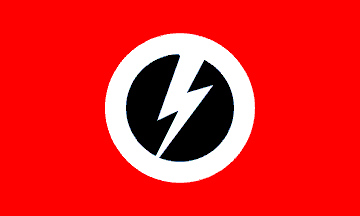 Top: Anarchist flag, used from 1991 to 2105. Bottom: Fascist flag, used from 2105 to present.
Top: Anarchist flag, used from 1991 to 2105. Bottom: Fascist flag, used from 2105 to present.
